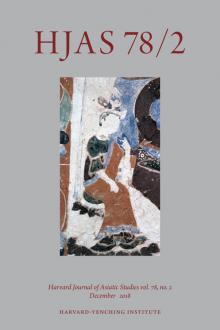December 2018
Artist unknown, Sui dynasty (581–618). Detail of west ceiling: Queen Maya, Dunhuang Cave no. 280, Gansu, China. Harvard Fine Arts Library, Digital Images and Slides Collection, 2001.00629, http://id.lib.harvard.edu/images/olvsite24499/catalog. Image courtesy of Harvard Fine Arts Library, Digital Images and Slides Collection.
Editorial Preface
Articles
History, Temporality, and the Interdynastic Experience
Yu Binshuo’s Survey of Nanjing (ca. 1672)
In this article, I examine the place of second-generation “remnant subjects” in the struggle to reconstruct Han literati collective identity following the traumatic Ming–Qing transition. The work of one such figure—Yu Binshuo (d. 1722), son of the better-known Yu Huai (1616–1696)—can be read as a response to inherited cultural trauma. Temporally removed from the Ming past, Yu’s Survey of the Ancient Sites of Jinling presents a subtly different kind of engagement with Ming cultural heritage than works of the eyewitness generation, yet Yu’s reimagining of Nanjing’s spatial order represents a discursive coping strategy that attempts to reclaim subjectivity in a time of loss. Understanding that loss as cultural trauma—a threat to both past and future identity—helps us to make sense of people’s experience of the extended cultural transition from Ming to Qing, as well as the operation and transmission of trauma more generally.
本文通過探究余賓碩寫的《金陵覽古》,對第二代遺民在清初社會的影響做了重新思索。雖然甲申之變時余氏尚幼,但他寫的六十首懷古詩表現了他對於明朝的深切怀想。作者認為,余氏所關注的是明朝的歷史記憶,及明代古跡在南京史上的地位。
Manuscript Culture and Chinese Learning in Medieval Kamakura
As medieval shogunate officials sought to project their influence outward over the land as well as in competition with one another, classical Chinese scholarship served as an important means of demonstrating cultural attainment and justifying authority. Despite the political and economic power of these figures, neither the texts themselves nor instruction in them were necessarily immediately accessible. I examine the reception of Chinese literary and philosophical texts in thirteenth-century Kamakura, reconstructing the modes of reproduction specific to such works within the larger medieval textual sphere. Analyzing paratextual features of one 1280 manuscript of the anthology Wenxuanindicates the institutional forces that slowed the efforts of eastern elites to replicate the cultural capacities of Kyoto. Such extant manuscripts provide the necessary evidence for a holistic analysis of medieval Japanese textual culture, revealing its network of circulation in the midst of historic changes.
帝王学としての古典籍は権力者にとって欠かせない道具であった。本論文は鎌倉中期における中国古典の複写・流通様式を分析し、関東武家が本の入手に如何に苦心したかを明らかにすると共に、鎌倉期写本を通し、京と新文化拠点との関係を書物の側面から考究する。
Pregnant Metaphor
Embryology, Embodiment, and the Ends of Figurative Imagery in Chinese Buddhism
Nurturing the embryo of sagehood was a widespread trope in premodern Chinese Buddhism. From its inception in the fifth-century apocryphal Sutra of Benevolent Kings, medieval Chinese Buddhist exegetes, Chan Buddhists, and Daoist inner alchemists all used this trope as both a metaphor for enlightenment and a metaphysical figure of supernatural embodiment—sometimes within the same textual passage. This trope’s historical use reveals an overlooked commitment on the part of many Chinese Buddhist thinkers to the notion that liberation entails the conception, gestation, and birth of supernatural bodies. The case of the embryo of sagehood demonstrates the capacity of figurative language to move fluidly across the boundaries of metaphor and metaphysics, a capacity I argue was a constitutive feature of premodern Chinese Buddhist soteriology.
本文探討「養聖胎」的概念在中國佛教的出現與演變。自五世紀的偽經以來,註釋家、禪師與內丹家都以聖胎作爲譬喻來代表覺悟,同時也把它理解為形而上超自然的身體。作者認為,聖胎的個案能夠闡明中國佛教形象化語言如何突破譬喻和形而上學之間的界線。
“I Write Therefore I Am”
Scribes, Literacy, and Identity in Early China
Scholarship usually accords early Chinese scribes little respect. The common perception is that they were nothing but low-level bureaucrats who carried out menial tasks in early imperial administration. But scribes saw themselves differently. Through an in-depth analysis of received literature and archaeological finds unearthed from the tombs of scribes, I argue that being a scribe was not only a privilege but also a matter of great pride to the individuals allowed to enter this profession. The fact that a significant number of tombs from the late fifth century BCE through the early first century CE yielded administrative and legal manuscripts in close proximity to writing utensils shows that literacy was the most crucial aspect of their identity. Their writing skills informed a sense of self that even extended into the afterlife.
學術界對古代文書(“史”)並不相當重視。文書通常僅被視爲古代政治制度中負責雜事的低級官吏,但是他們對自己的身份卻有完全不同的看法。通過對文獻與墓葬考古的深入研究,本文的結論是文書認爲這一職业不但是一種特殊榮幸譽,同時也是個人的驕傲。
